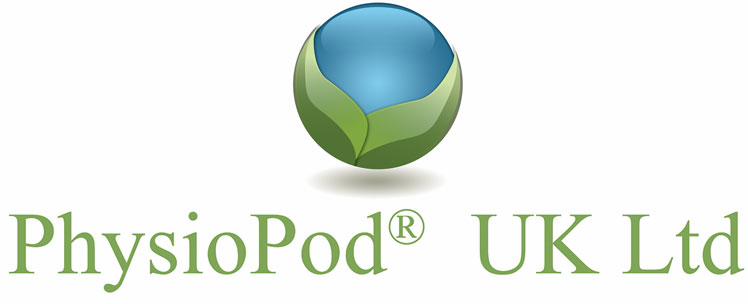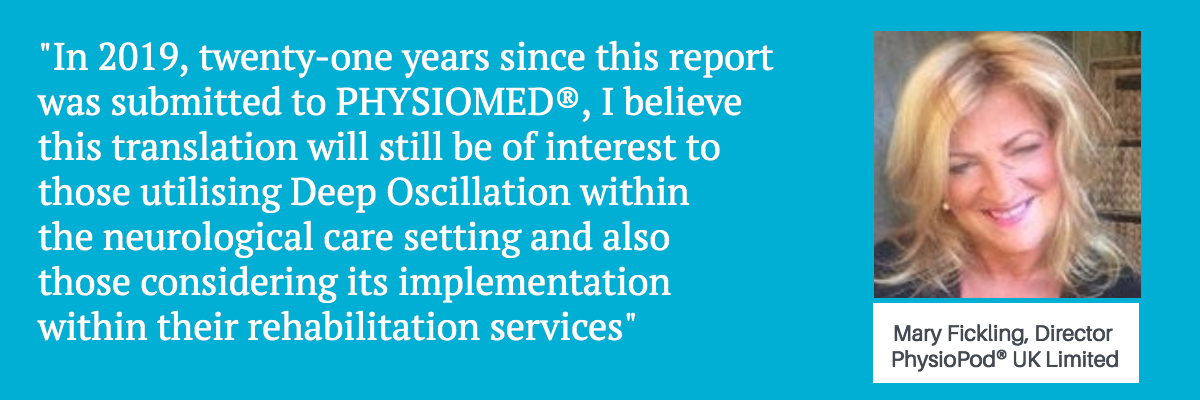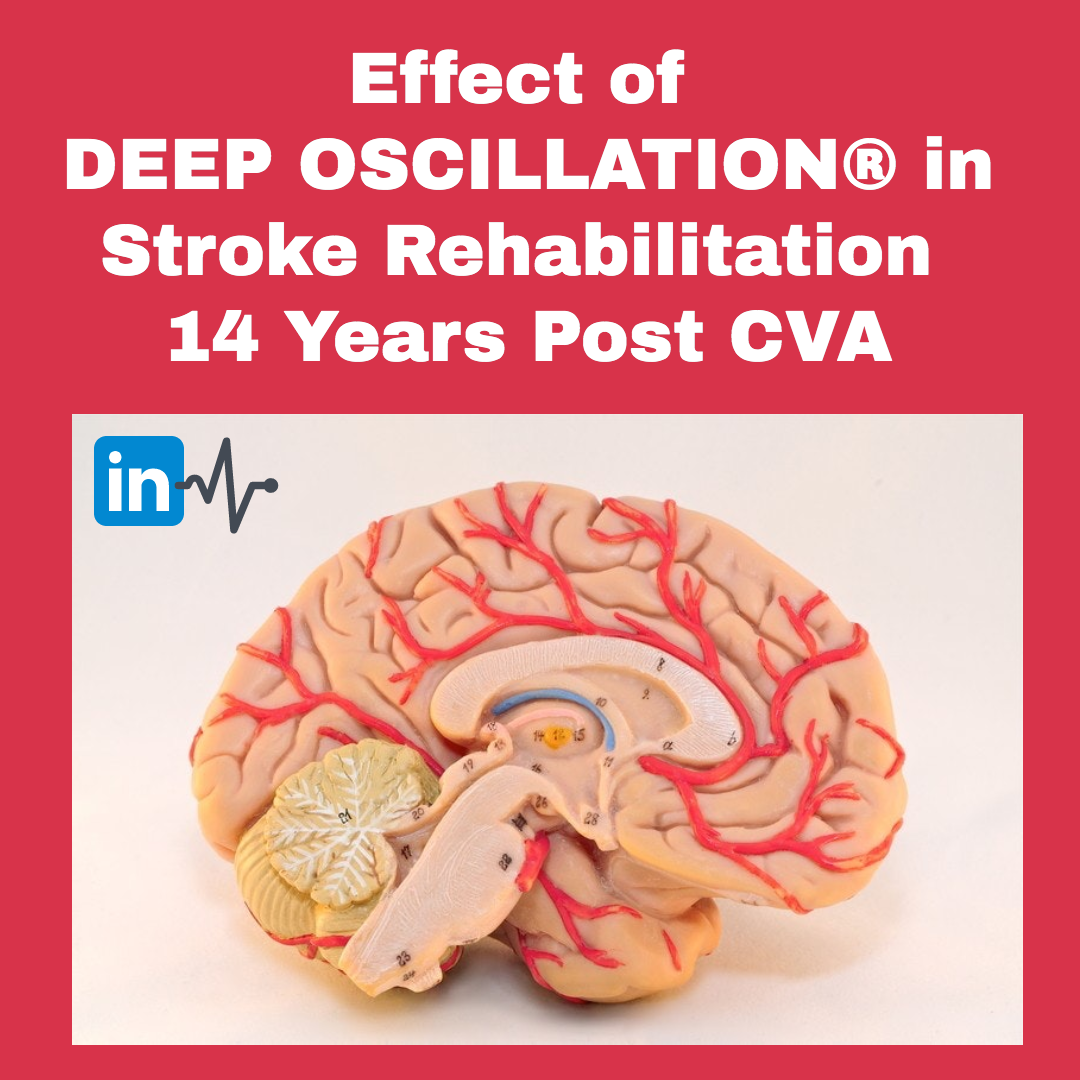“It is not always about developing new methods and procedures. Sometimes we have to adapt methods and procedures to the individual conditions and requirements of the patients and to observe them in the process and evaluate the results.
Vibration is not a new method. Already in early civilisations, we knew of their soothing and relaxing effect, which was enjoyed by all. Vibration is one of the most progressive forms of motion and we find vibration in many cells and tissues as a vegetative movement function.
Normally, vibration is manual or with the aid of massage devices and the efficacy limits of these treatments are known. The intensity of the treatment, frequency or dosage can only be controlled to a limited extent, depending on the device type.
For the treatment of my patients with vibration I have searched to:
- Prevent mechanical stresses of the upper skin or at least significantly reduce them
- Not produce any crimping impact
- Stimulate muscles and nerves
- Provide a relaxing treatment
I have found this possibility with Deep Oscillation, which I had the opportunity to test for six months.
Patient One
After a moderate degree of right-hunched apoplexy, a left-sided hemiparesis has appeared which shows only a few spastic patterns. The muscle tone is rather slack. Active and passive exercises are conducted by the PT.
P suffers from severe depression and refuses almost all other therapies. The ET treatment was also met with great scepticism. P refuses to carry out any activities.
P found the treatment with deep oscillation to be extremely pleasurable and became increasingly positive about the treatment (F = 60 Hz-150 Hz). In the second half of treatment, treatment frequency was reduced as the muscular tone has already improved significantly, the vibration has led to a different new perception of the arm, as the basis for a movement approach has been developed, the constrictive mean has been loosened by the treatment. His ability to walk has improved.
Patient Two
P. regularly suffers from severe pain in the shoulder and cervical area. These pains are dependent on physical and psychological stress. After the treatment with deep oscillation (F = 120 Hz/160 Hz/80 Hz - M = 1:1, T = 20 min, D = 60-80%) the pain is immediately improved. Usually he is then 3 - 5 days without pain. The syndrome-induced movement restrictions are also no longer observed during this time.
Patient Three
Acute treatment for muscular pain (tension or sore muscles). After two treatments (F = 120 Hz, M = 1:1 T = 15 min D = 50%), patient was free of pain. There were no more motion restrictions.
Patient Four
Grasping exercise resulted in an amplification of the pain in the finger joint. The ability to move reduced. When using low-frequency vibrations, the arm muscles relax visibly. With a foam rubber ball I have strongly dampened the mechanical vibration and started massaging the hand with increasing frequency. After about 5 minutes of treatment, P. described a change of the pain perception. The pain was now no longer "sharp, but dull-pulling." After a further 5 minutes, his pain was gone.
After the treatment the mobility was improved. However, the effect of this treatment method was only for 10-30 min. Then the previous condition reappeared. Treatment of the forefoot with this method was only very limited. Possible, the mechanical impact was felt as too strong. Already after the first treatment with deep oscillation (F = 70Hz, M = 1:1 T = 10 min and D = 40%), a clear change was observed. The change in pain was much more rapid. The improvement in motility was significant.
After the second treatment P. reported that the effect had lasted for 12 hours. The following procedures resulted in an increased duration of action and a further improvement in the ability to move. Today, the fundamental functional capability of the hand is almost completely established. Sensitivity disorders no longer occur. The sensory disturbances in the left leg are also no longer present. Only on the back of the foot there is still a small segment with sensory disturbances. The driver works normally. P. is already running without orthoses.
Patient Five
At the beginning of the ET treatment, the PT treatment had already been discontinued since P. was immediately reacting with a strong spastic activity in every passive movement, which in some cases also caused him great pain. The arm joints and wrist were only a little stretchable (10-30°).
I first start the treatment with a mechanical vibration. But also spastic activity was frequently observed. The respective duration of the treatment should therefore be kept very short (3-5 minutes per side). In the treatment with deep oscillation, I first observed the known spasm. This occurred at first in the beginning. In the second treatment series, there were increasingly treatments where this activity was no longer observable. I treated in two phases:
First, I started with a high frequency (F = 120 Hz) and then continued with a medium-frequency treatment (F = 40-60 Hz). During treatment muscles relax noticeably. Treatment time increased slowly from T = 5 min to T = 15 min for each side. P shows wellbeing. The possibilities of passive exercises are increasing. The arms and wrists are passively stretchable again. First rotations are possible again. In these passive movement disorders after treatment with deep oscillation only very rarely spastic activities occur.
Patient Six
In addition to severe tetraspastics with strong contractures the low muscle volume in the arms and legs was also noticeable. In the ET assessment, besides the almost tactile stimuli, e.g. in passive motions lead to spastic activities. Already during the treatment with mechanical vibration, I had been able to ensure that at high frequencies, there was a direct relaxation and the absence of the spastic activities.
The treatment with deep oscillation has significantly increased this effect. After 18 treatments, arms can be passively extended almost to a full extent, without provoking spastic activities. After each treatment, a loosening of the musculature and a deeper improvement of the blood circulation can be observed. P. is evidently very well at treatment. In this treatment too, the pulse described above is occasionally observed.
Patient Seven
An atypical spastic tetraparesis was determined during the assessment, i.e., the spastic activities do not follow a regular structure. They cannot be triggered intentionally nor are they constantly present. An incident-like event cannot be completely ruled out. The aim of the treatment is to maintain the active and passive mobility of the arms and hand, with simultaneous neuromuscular stimulation (F = 25 Hz - 50 Hz, M = 1:1, T = 5-10 minutes per side, D = -60%)
Patient Eight
At the centre of therapy was the treatment of contractures in the arm and wrists. After about 10 treatments (frequency (F) between 60Hz - 130 Hz in the 1:1 mode (M), with 8 -15 min treatment time (T) per side and a dose (D) of 60%) a nearly passive stretching of the joints on the right and the elbow arch on the left was possible. P. reacted in the shortest generalised spastic activity, to which I gave the working title, "Pulse spasms." The pulse spasm now occurs only occasionally. Occasionally he falls asleep during treatment. The patient has a clear expectation of the treatment as soon as the therapist is recognised.
Patient Nine
Syndrome ingest the contractures on the arm and hand gels. Particularly affected is the left arm. About one year ago, the arm could still be stretched as far as the wrist. After a 3-month treatment of occupational therapy (physiotherapy was further prescribed) the stretching was only possible to a very limited extent. The therapy with deep oscillation (usually F = 80 Hz - 100 Hz, M = 1:1, T = 10-1 min per side, D = 70-50%) brought about an increase in the muscle tone of the stretched muscular system and an improved stretchability to 25 -30 degrees.
Patient Ten
Acute treatment for migraine patient. P. came with severe headaches for treatment. The headaches were preceded by pain in the shoulder girdle. Partially, these pains still exist. After treatment with deep oscillation (F = 100 Hz -120 Hz, M = 1: 2, T = 20 ~ 30 min, D = 60 -80%), pain relief immediately occurred. About 20 min after the treatment P. was pain-free.
Patient Eleven
Acute treatment by a migraine patient, the procedure was performed in the same manner as for ten. After treatment with deep oscillation (F = 100-120, M = 1: 2, T = 20 ~ 30 in, D = 60-80%) P. did not complain of pain in his shoulders
My Observations of working with Deep Oscillation
Tissue structures are becoming increasingly loose and can be moved more freely. At the beginning of the treatment, pain spots show a reddening, which then reduce during the course of the treatment.
In addition to local activity, a general activation is often observed.
Patients should not be treated with the same treatment parameters for each treatment. They react differently day-by-day. The optimal setting has to be found for each treatment. It is only after a period of treatment that a kind of habit occurs. The treatment parameters then fluctuate only slightly.
All Patients perceive treatment as exceptionally pleasant; their mental attitude towards the healing process is good.
Multiply handicapped P. show predominantly positive reactions in the treatment. Obviously, this treatment method is also suitable for P. with spastic activities.
Note: Very low frequencies can also be used to support sensory stimulation. However, these have no direct detectable effect on the muscle tone.
Note: Patients report numbness during deep oscillation treatment. This is particularly intense at high frequencies. However, the short treatment at a low frequency immediately reduces this feeling.
Patient Feedback of Deep Oscillation
- A tingling sensation
- Pleasant relaxation
- The vibrator soothes
- It helps and does not hurt
- Had not thought that I could tolerate the contact, but I could
- Can we make such a thing regular treatment?
- Felt vibrating through the whole arm into the fingertips
- The arm felt light and much easier
- It is warm, almost hot
- Patients with the most severe mental disabilities show, among other things: to be relaxed with more salivary flow





